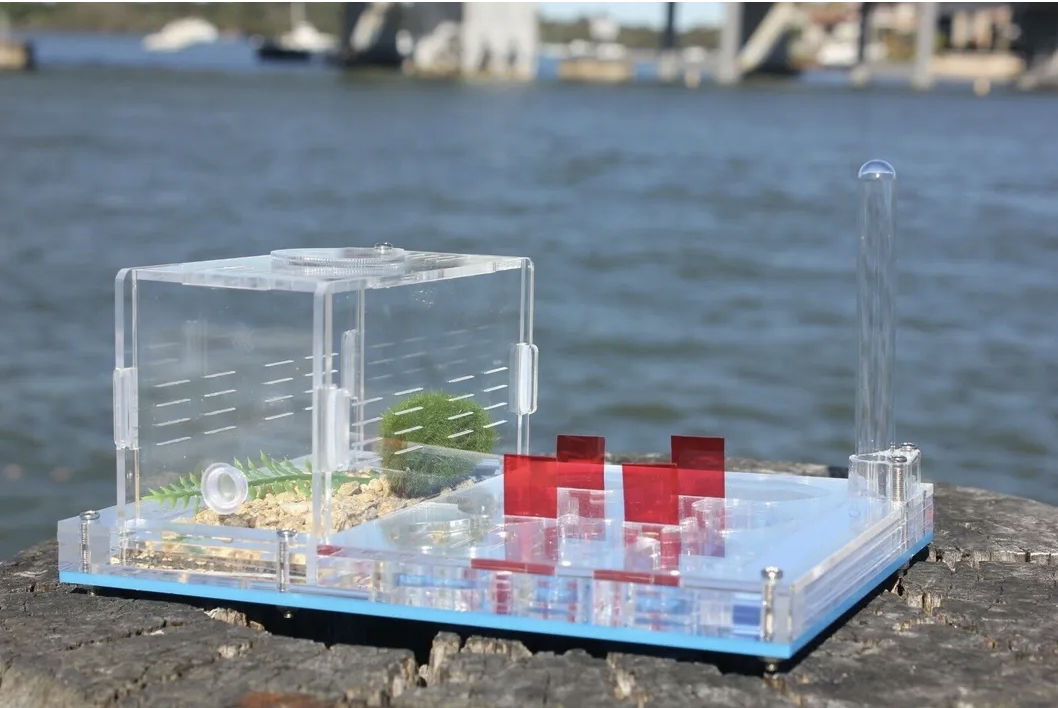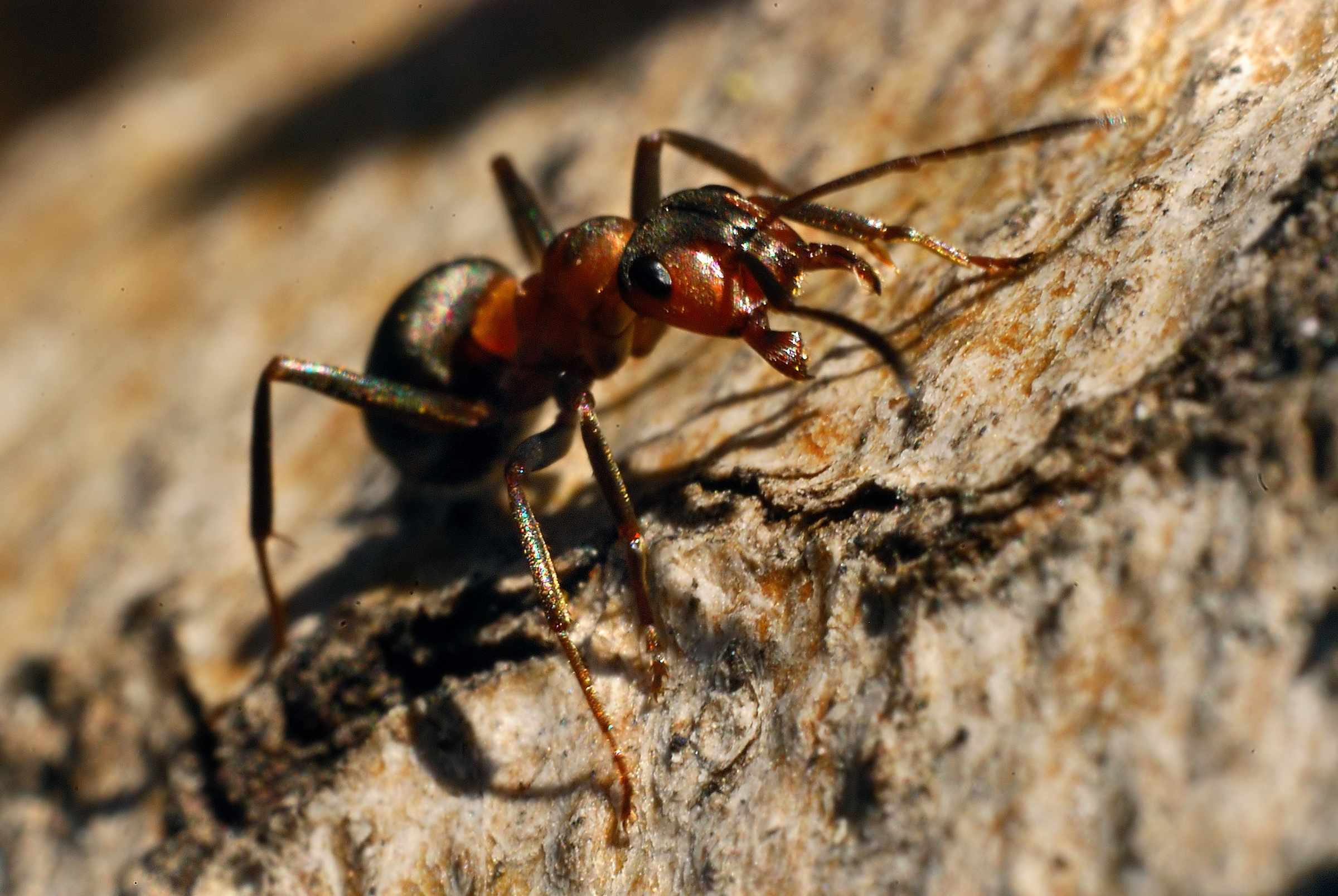ANT KEEPING 101
Lets learn about ants!
Quick Guide to Raising an Ant Colony
Raising an ant colony can be a fascinating and educational experience. Here’s a basic guide to get you started:
- Research and Choose Ant Species:
– First, research different ant species to find one that suits your preferences and location. Common choices include harvester ants, carpenter ants, or red imported fire ants.
– Ensure that it’s legal and safe to keep the chosen species in your area. - Gather Supplies:
– You’ll need an ant farm or formicarium, which is a container designed to house ants. You can purchase one or make your own using a clear container, sand, and connectors or tubing for tunnels.
– Other supplies include a water source (like a small dish with a sponge), ant food (honey, sugar water, insects), and a source of heating or cooling if required by your chosen species. - Capture or Purchase Ants:
– You can capture a queen ant and a few worker ants during a nuptial flight (mating event) or purchase them from a reputable ant supplier.
– Make sure the queen is fertilized and healthy, as she will be the heart of your colony. - Set Up the Ant Farm:
– Create a suitable environment within your ant farm. This typically involves adding sand or soil for tunneling, a nesting area for the queen, and a foraging area where you’ll place food. - Monitor and Maintain:
– Keep the environment clean and free of contaminants. Ants are sensitive to chemicals, so avoid using pesticides or cleaning agents near the ant farm.
– Provide a consistent temperature and humidity level that matches the requirements of your chosen ant species.
– Regularly check for any issues like mold, escaped ants, or disturbances in the colony. - Feeding and Watering:
– Ants require a balanced diet. Feed them a variety of foods like honey, sugar water, small insects, or commercially available ant food.
– Ensure a constant water source, such as a moist sponge or water tube, in the foraging area. - Observe and Learn:
– Spend time observing your ant colony. You can learn a lot about their behavior and social structure through careful observation.
– Document their activities and growth in a journal. - Expand the Colony:
– As your colony grows, you may need to provide more space and resources. Add additional tunnels or chambers to the formicarium, and continue to monitor their needs. - Educate Yourself:
– Stay informed about the specific needs and behaviors of your chosen ant species. There are many online communities and forums where ant enthusiasts share information and experiences. - Enjoy the Experience:
– Raising an ant colony can be a rewarding and educational hobby. Take pleasure in watching your ants thrive and grow.
Remember, ants are complex creatures, and raising a colony can be challenging. Be patient and willing to adapt as you learn more about your ant species and their needs. Always prioritize the well-being of your ants and respect any legal restrictions in your area regarding keeping them as pets.


How do you identify an ant queen?
Identifying an ant queen can be a bit tricky as they often look different from worker ants of the same species due to their larger size and distinct body features.
Here are some key characteristics that can help you identify an ant queen:
- Size: Queen ants are generally larger than worker ants. They can be several times the size of worker ants in the same colony.
- Wings: In many ant species, including those that undergo nuptial flights (mating events), queen ants have wings. These wings are typically longer than their bodies. After mating, some queen ants shed their wings, but others retain them.
- Thorax: The thorax of a queen ant is usually larger and more pronounced than that of worker ants. It’s where the queen’s wing muscles are located.You could see wing scars in those who have chewed off their wings after they nuptial flight.
- Abdomen: Queen ants have a more elongated and often more bulbous abdomen compared to worker ants. This is because the queen’s abdomen is designed to hold and lay eggs.
- Color: The coloration of a queen ant can vary depending on the species, but they often have the same general coloration as worker ants in their colony.
- Behavior: Queen ants are rarely seen outside of the nest, as their primary role is laying eggs and being cared for by worker ants. If you spot an ant inside the nest that is significantly larger than the others and is not foraging or performing typical worker ant tasks, it’s likely the queen.
Keep in mind that ant species vary in appearance, and some queens may closely resemble worker ants. Additionally, winged queens may be seen during a nuptial flight, which is when they mate and establish new colonies. If you’re uncertain about the identification of an ant as a queen, consulting ant identification guides or experts in ant biology can be helpful.
How do you catch a queen ant?
Catching a queen ant, especially during a nuptial flight (mating event), requires some preparation and patience. Here are steps to help you catch a queen ant:
- Research Your Local Species: Understand the ant species that are native to your area and their typical mating seasons. Different species have different flight patterns and times.
- Gather Supplies:
– You’ll need a collection container, such as a test tube or small container with a lid.
– Prepare a suitable nesting setup for the queen. This could be a small formicarium or nest, or even a test tube setup for temporary housing. - Timing is Key:
Be ready during the mating season of the ant species you’re targeting. Nuptial flights usually occur after rain and are often triggered by specific weather conditions. - Locate a Nuptial Flight:
Look for swarms of flying ants around dusk or dawn. These are the potential queen ants and male ants (drones) taking part in the mating flight. - Be Patient:
Nuptial flights can be brief, so you may need to wait for the right moment. Observe the ants and watch for queens landing. - Capture the Queen:
– Once you spot a queen landing, gently and carefully capture her using your collection container. Approach slowly to avoid startling her.
– If she has already shed her wings, you can identify her as a queen based on her larger size and distinct features. - Handle with Care:
Be gentle when handling the queen to avoid injuring her. Use a soft brush or a piece of paper to encourage her into the container if necessary. - Transfer to a Nest:
Place the captured queen in her new test tube setup, ensure she has access to water and leave her in a quiet, dark place for a few days or weeks to settle. - Wait and Observe:
Monitor the queen’s behavior. If she’s fertile and successfully mated, she’ll eventually start laying eggs, and a new colony will develop. - Provide Care:
Continue to provide her with food and water as needed, and be patient as the colony grows.
Remember to handle queen ants with care, as they are critical to the colony’s survival. It’s important to release any unwanted ants back into their natural habitat after you’ve identified them if you don’t plan to keep them as pets. Additionally, ensure that capturing and keeping ants as pets is legal in your area and follow ethical practices in ant keeping.
How do you know if your queen ant is mated?
Determining whether a queen ant is mated can be challenging without specialized equipment or observation tools. However, there are some indirect signs that may suggest a queen ant has successfully mated:
- Wing Removal:
If you caught the queen during a nuptial flight and she has shed her wings, it’s a strong indicator that she has mated. After mating, queen ants typically remove their wings, as they no longer need them. - Increase in Abdominal Size:
A mated queen’s abdomen will gradually increase in size as she stores sperm from the mating flight. This enlarged abdomen is necessary for her to lay eggs over an extended period. - Egg-Laying:
The most definitive sign that a queen ant is mated is when she begins to lay eggs. Mated queens can lay fertilized eggs, which will develop into worker ants and new queens, as well as unfertilized eggs that become male ants (drones). - Behavior:
A mated queen will exhibit nesting behavior, such as seeking a suitable location for egg-laying and protecting her brood. - Presence of Workers:
Once the queen’s eggs hatch and mature into worker ants, it’s a clear indication that she is mated. Worker ants are a sign of a functioning colony. - Longevity:
Mated queen ants tend to have a longer lifespan compared to unmated queens because they can continuously lay eggs over time.
It’s important to note that some ant species have complex mating behaviors, and not all queens will be successful in mating during their nuptial flight. Additionally, the process of sperm storage and egg-laying can vary among species.
To be absolutely certain that a queen is mated and has stored sperm, you would need specialized equipment like a microscope to examine her reproductive system. In most cases, observing the queen’s behavior and the development of a growing colony should provide enough evidence that she has mated successfully.
What is a nuptial flight?
A nuptial flight, also known as a mating flight or dispersal flight, is a remarkable event in the life cycle of many ant species. It is a synchronized, mass emergence of winged reproductive ants (queens and males) from an established ant colony. Nuptial flights are a crucial part of the ant reproductive process and serve several purposes:
- Mating:
The primary purpose of a nuptial flight is for virgin queens and males to find mates from different colonies. This genetic diversity helps maintain the health and adaptability of ant populations. - Colony Establishment:
After mating during the flight, fertilized queens will eventually land and start new colonies. The stored sperm from the mating allows the queen to lay eggs and establish her own colony. - Reduction of Inbreeding:
Nuptial flights reduce the risk of inbreeding within a colony because queens mate with males from different nests. This genetic diversity is essential for the long-term survival and adaptability of ant colonies.
Nuptial flights typically occur under specific environmental conditions, often triggered by factors such as temperature, humidity, and daylight. Different ant species have their own timing for these events, and they may occur once a year or less frequently.
During a nuptial flight, winged queens and males emerge from their colony’s nest and take to the air. They fly for a certain distance, and then the males release sperm, which the queens collect. After mating, the queens land, shed their wings, and search for a suitable location to start a new colony. The males, having served their purpose, usually die shortly after mating.
Nuptial flights are a crucial aspect of ant ecology and play a significant role in the life cycle and population dynamics of ant colonies. They also provide opportunities for ant enthusiasts and researchers to study and collect ant species for scientific purposes or hobbyist ant-keeping.
